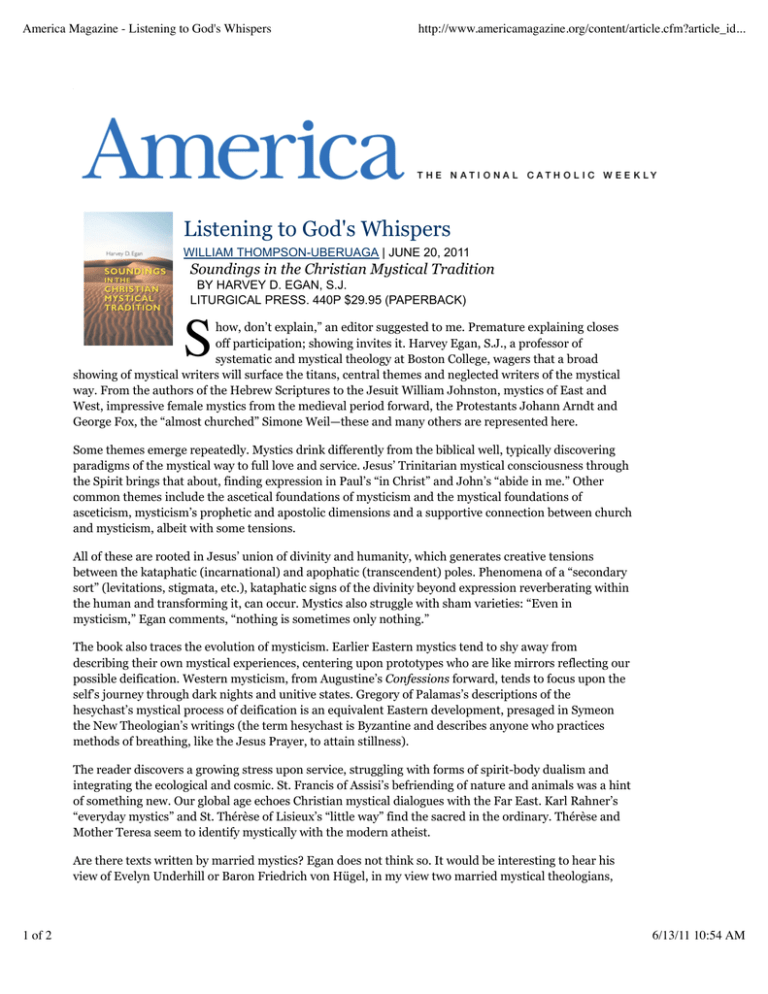America Magazine - Listening to God's Whispers
advertisement

America Magazine - Listening to God's Whispers http://www.americamagazine.org/content/article.cfm?article_id... Listening to God's Whispers WILLIAM THOMPSON-UBERUAGA | JUNE 20, 2011 Soundings in the Christian Mystical Tradition BY HARVEY D. EGAN, S.J. LITURGICAL PRESS. 440P $29.95 (PAPERBACK) S how, don’t explain,” an editor suggested to me. Premature explaining closes off participation; showing invites it. Harvey Egan, S.J., a professor of systematic and mystical theology at Boston College, wagers that a broad showing of mystical writers will surface the titans, central themes and neglected writers of the mystical way. From the authors of the Hebrew Scriptures to the Jesuit William Johnston, mystics of East and West, impressive female mystics from the medieval period forward, the Protestants Johann Arndt and George Fox, the “almost churched” Simone Weil—these and many others are represented here. Some themes emerge repeatedly. Mystics drink differently from the biblical well, typically discovering paradigms of the mystical way to full love and service. Jesus’ Trinitarian mystical consciousness through the Spirit brings that about, finding expression in Paul’s “in Christ” and John’s “abide in me.” Other common themes include the ascetical foundations of mysticism and the mystical foundations of asceticism, mysticism’s prophetic and apostolic dimensions and a supportive connection between church and mysticism, albeit with some tensions. All of these are rooted in Jesus’ union of divinity and humanity, which generates creative tensions between the kataphatic (incarnational) and apophatic (transcendent) poles. Phenomena of a “secondary sort” (levitations, stigmata, etc.), kataphatic signs of the divinity beyond expression reverberating within the human and transforming it, can occur. Mystics also struggle with sham varieties: “Even in mysticism,” Egan comments, “nothing is sometimes only nothing.” The book also traces the evolution of mysticism. Earlier Eastern mystics tend to shy away from describing their own mystical experiences, centering upon prototypes who are like mirrors reflecting our possible deification. Western mysticism, from Augustine’s Confessions forward, tends to focus upon the self’s journey through dark nights and unitive states. Gregory of Palamas’s descriptions of the hesychast’s mystical process of deification is an equivalent Eastern development, presaged in Symeon the New Theologian’s writings (the term hesychast is Byzantine and describes anyone who practices methods of breathing, like the Jesus Prayer, to attain stillness). The reader discovers a growing stress upon service, struggling with forms of spirit-body dualism and integrating the ecological and cosmic. St. Francis of Assisi’s befriending of nature and animals was a hint of something new. Our global age echoes Christian mystical dialogues with the Far East. Karl Rahner’s “everyday mystics” and St. Thérèse of Lisieux’s “little way” find the sacred in the ordinary. Thérèse and Mother Teresa seem to identify mystically with the modern atheist. Are there texts written by married mystics? Egan does not think so. It would be interesting to hear his view of Evelyn Underhill or Baron Friedrich von Hügel, in my view two married mystical theologians, 1 of 2 6/13/11 10:54 AM America Magazine - Listening to God's Whispers http://www.americamagazine.org/content/article.cfm?article_id... mystagogues (those who guide others on mystical paths) and mystics of the most profound sort. The overwhelmingly Roman Catholic perspective of this book may play a role here, for the celibate religious orders possess the institutional framework within which mystical texts might emerge, be published and achieve notoriety, although this is changing ever so slowly, sometimes through the religious orders’ developing of lay associates. But I agree with Egan’s view that sexual intimacy must achieve a radical de-centering for marital mysticism to move to its full potential. A brief and solid introduction offers helpful perspectives. Egan accepts Bernard McGinn’s view that “the mystical element in Christianity [expresses] the consciousness of, and the reaction to…the direct presence of God.” Thus the mystical, as part of a living tradition, is not unchurched or without dogma, and God’s “presence” is mysticism’s goal, though Egan would add an occasional consciousness of God’s absence. Distinguishing between mystic, mystagogue and mystical theologian, Egan considers Bernard Lonergan, S.J., for example, to be a mystical theologian but not a mystic or mystagogue. At times who is one or the other remains unclear, perhaps deliberately on the author’s part. While the relation between mysticism and sanctity is fluid for Egan, they should not be completely confused. A married saint, for example, can brim with love, but not necessarily be a mystic. Unless one eliminates the one thing necessary for authentic mysticism in the judgment of most of the mystics, namely love, cannot any saint be a mystic? Perhaps not a writer of mystical texts, but then again, do all mystics need to have the charism of writing? Mystagogues and mystical theologians would tend to have the writer’s gift. Perhaps the words “mystic” and “saint” highlight specific features of one and the same reality (St. Teresa of Avila’s many rooms of one castle)? This understanding would jibe with Egan’s view of the fluid relationship between them, implying that a distinction cannot be a separation. The martyr’s de-centering—a centering beyond the self and toward the Other—is temporally speedy but qualitatively radical, perhaps implying a rich fluidity between martyrdom and mysticism. Egan’s style is open and positive as he engages the serious reader. A true son of St. Ignatius of Loyola, he will first attract and then guide the reader to Jesus Christ, the mystic paradigm, but in a way that draws along the full potential of the reader. The book has no conclusion—which perhaps suggests we will have to supply one from our own experience walking the mystical way. William Thompson-Uberuaga, of Meridian, Idaho, is emeritus professor of theology at Duquesne University. His most recent book is Jesus and the Gospel Movement: Not Afraid to be Partners (Univ. of Missouri Press). 2 of 2 6/13/11 10:54 AM








